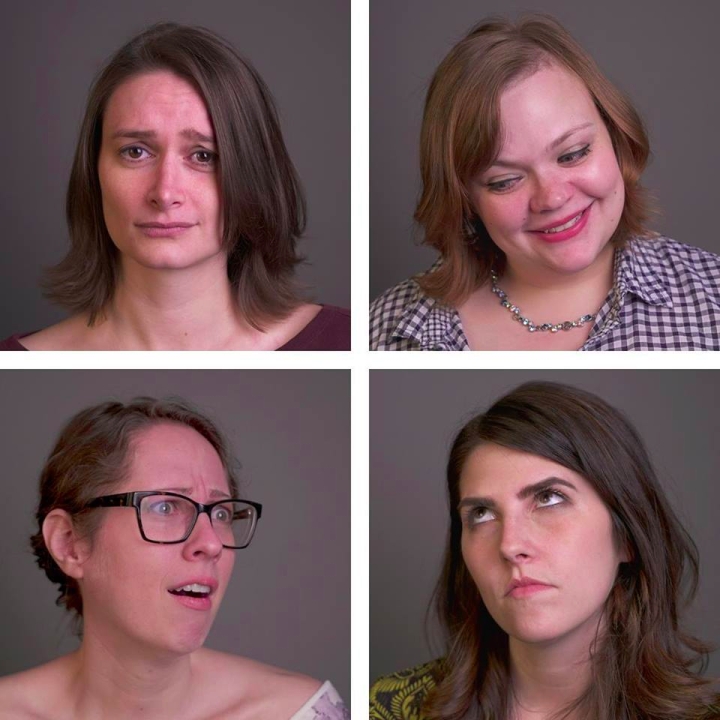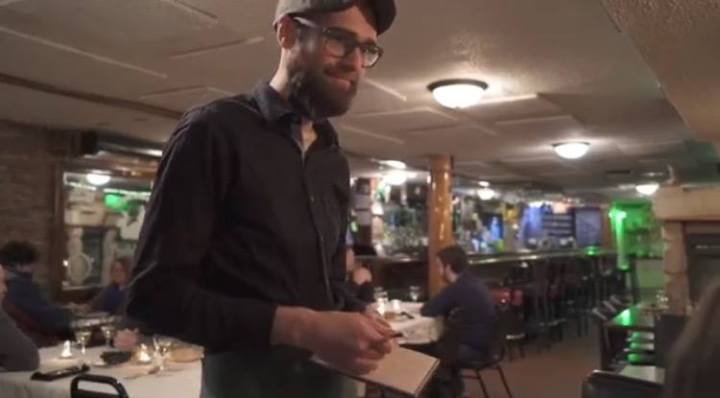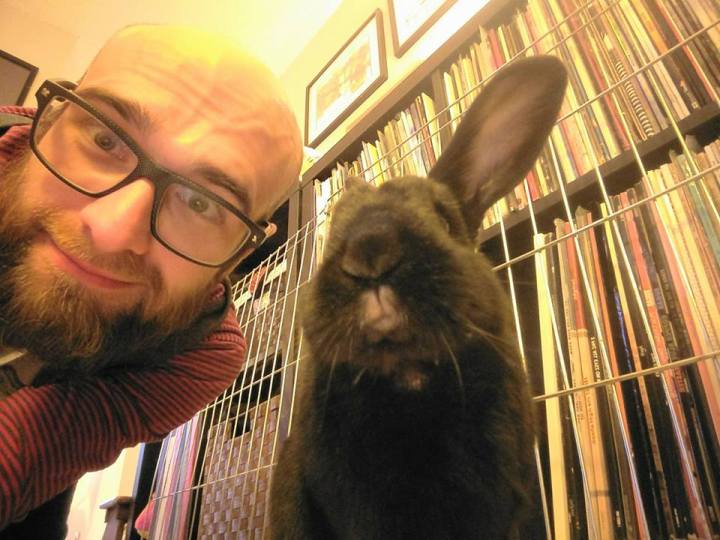
By Kevin Krein
During the two years I wrote for the Northfield News, one of the areas I covered was that of the local arts and entertainment scene. That meant I wrote about a lot of bands playing in bars, a lot of art exhibits and gallery openings, and a lot of plays being produced by the community theatre companies in the area.
My wife Wendy is relatively active in the theatre community, so a few times I profiled a production that she was involved in. Due to what my editors (and most people, probably) would call a conflict of interest, I could never interview her for the story. However, this did not stop me from joking with her about what the story would have turned out like: “The play features area actress Wendy Placko, the prettiest and most talented member of the cast.”
For the last year and a half, give or take, my wife and three of her friends have been writing, filming, editing, and starring in a 6- episode web series entitled “Lady Parts.” And here, it seems worth noting that you should just follow the links to the website and to their Facebook page and that you should not, under any circumstances, Google “Lady Parts,” especially if you are at work, or on a public computer.
If memory serves me correctly, the working title for the project was “Women Aren’t Funny” (it turns out that was taken already by a documentary), and for a while, they were tossing around the name “#SquadGoals,” but that didn’t seem like it would age incredibly well.
The name “Lady Parts” comes from a couple of different places—the first, and probably most important, being the reason Wendy wanted to take this project on at all. She, as well as two of her “Lady Parts” collaborators, Birch and Anne, agreed that there was a lack of good comedic roles (or parts, if you will) for women in local theatre productions, and writing their own series was one way to remedy this problem.
The second comes from the different roles, or parts, that women play in their respective lives and careers—among coworkers, friends, and near strangers.
And the third? That’s the obvious innuendo you’ve been expecting: vaginas.
The first meeting between Wendy, Anne, Birch, and Andi took place at the beginning of 2016 over an elaborate vegan and gluten-free brunch at our home, where the four of them discussed the project and its potential. The idea for the series and the characters they’d be playing slowly started to take shape—they would be playing semi-fictionalized, hyper-exaggerated versions of themselves, falling into specific archetypes.
In the first episode, the conceit that brings the characters together is that they are all attending a bachelorette party where the bride-to-be is a no show, and therefore, the four are forced to get along with one another. Subsequent episodes would focus more on one character than the others, and over time, friendships of sorts would develop.
Wendy began writing the script for the first episode, and started to structure outlines and character arcs for the additional episodes; filming of the first episode, “Bachelorette Slumber Party,” took place in February 2016—in the basement of the house that Anne and her husband Peter (my childhood best friend) were living in at the time.
I helped where I could—carrying equipment, moving and monitoring the camera as best I knew how to at the time, and referencing the script to assist when someone flubbed a line.
But not every episode of “Lady Parts” could be written around only four characters, set in one, moderately claustrophobic location; shortly after, the scripts started to call for more and more elaborate locations, and additional bodies. Wrangling the schedules of the four core cast members became more and more difficult.
* * *
The second episode focused on Birch, a stay-at-home mother who becomes obsessed with presenting the perfect façade through lifestyle blogging. The script called for destruction of property, the use of Birch’s own children as characters, and the first of many ‘walk and talks,’ a device that Wendy would later regret writing into so many episodes because they were hard to film properly.
The third episode focused on Wendy’s character, single and lonely, who is subjected to cat calling; out of fear of dying alone, she goes on a date with her street harasser. This time, the episode concluded with the date—dinner in a restaurant.
Production on the second episode wrapped in the early spring of 2016, and work on the third episode started shortly after that in late spring and early summer. But this is when life started to get in the way: both Anne and Wendy took roles in musicals—“Grease” and “The Little Mermaid,” respectively; Andi was knee-deep in creating visual art for a grant funded gallery exhibition; and Birch and her husband were preparing for the birth of their third child.
The band wasn’t breaking up, but between scheduling logistics, as well as the initially overwhelming concept of filming on location and wrangling extras for scenes, “Lady Parts” was on hiatus.
* * *
The thing with “Lady Parts” is that, from the first day of shooting until the very recent conclusion, it was a learning process—mostly for my wife, but for everyone else involved as well. The first two episodes were filmed with minimal equipment: the camera was borrowed, and there was little, if any, equipment for sound. But the larger the scope of each episode and each scene grew, the more elaborate and, at times, complicated the technical aspect to the show became.
During the show’s hiatus, it was uncertain how much of the borrowed equipment the crew would be able to use in the inevitable future. It was during this time that Wendy decided to write a Southeastern Minnesota Arts Council (SEMAC) “Emerging Artist” grant proposal, with the hopes to use the funding in order to buy a camera and for production to resume.
When SEMAC hands you $2,500, they don’t just toss a check in the mail and never want to hear from you again. They want results—and this is how “Lady Parts” wound up being completed.
At the start of the new year, with a newly purchased, high-end camera in hand, the group reconvened in whatever configurations they could, nearly every weekend, to continue filming the rest of the series—the conclusion of episode three (the restaurant scene), episode four—focusing on Anne’s cold hearted and career driven character who is desperately seeking validation and a promotion at work, and episode five—following Andi, the cynical and brash visual artist, struggling with “artist’s block” as she attempts to complete her own grant funded art show, a stark example of life imitating art.
Episode six, the “Lady Parts” finale, and possible magnum opus, found the group taking on a task more difficult than securing locations for a shoot, or finding extras willing to commit to an early Sunday morning call time. They filmed at a public event—the March For Women in St. Paul—and loosely constructed scenes as their characters with improvised dialogue, all to be used in a yet-to-be planned episode that would find the four women again in a claustrophobic space: the car ride up to the march, where they begin to argue about whose definition of “feminism” is the right one.
All of this—the writing, filming, and editing (the most labor intensive and maddening of all) needed to be completed by the end of June—in time for Wendy’s SEMAC Capstone event, a requirement of the grant funding—a public screening of all six episodes followed by a talkback on the process.
* * *
In the world of “Lady Parts,” only Birch’s character is married and has a family, but off-screen, that isn’t the case; everyone has a husband, and for a while, there was a joke that a companion series featuring the spouses be developed. Some people called it “Boy Parts” (again, something I would strongly discourage you from searching on the internet.)
I referred to it as “Husband Parts.”
In the early days of filming, I assisted where and when I was able based on my own work schedule at the time. I learned how to balance a camera on a small tripod stuffed in my shirt pocket so it would be moderately.stable, as I crouched and shuffled backwards to film a walk and talk.
I sat on a skateboard that was rigged to roll somewhat smoothly over a series of flattened boxes, and allowed myself to be pulled back, all while zooming the lens of the camera in for a tight close up to try to achieve a specific shot Wendy wanted (it kind of worked. Kind of.)
I ran to Target to buy more memory cards. I wrapped audio cables. I read scripts and gave feedback. I watched rough edits of episodes and tried to provide suggestions on where something could be tightened up. I held the boom microphone attached to a broom handle above my head and hoped I was picking up enough sound.
I was cast as a waiter in the restaurant scene, and the only direction I was given was to be “as shitty as possible.” I was asked to do the Glengarry Glen Ross-inspired voice over work for the “motivational” podcast Anne’s character listens to in episode four.

By the time the “Lady Parts” hiatus was over, and filming resumed, I had changed jobs, and my work schedule didn’t allow me to help as often on the weekends.
My “Husband Part” changed then—from one of helping, or assistance, to one of support and remaining patient.
I kept the house afloat on evenings while Wendy was editing together episodes; I kept our companion rabbit company and tried to make something that resembled dinner.
More important than banal chores like the dishes and loads of laundry, I was there to listen and to offer encouragement, like when there were tensions between cast members that needed to be worked out, or when the entire project just seemed like it was too much and would never actually be finished.
In episode six, on the way to the Women’s March, the question of how one “smashes the patriarchy” comes up—it’s this question that sets the stage for the dissention that occurs in the car. Following the SEMAC Capstone screening of “Lady Parts,” during the talkback portion, a male audience member asked, “How does one smash the patriarchy?”
My wife Wendy surprised me by answering that people should be “more like my husband.” It was a surprise to hear her say that because I don’t think I am doing anything out of the ordinary, or extra special.
Early on in the “Lady Parts” process, when individual episode ideas were being tossed around, I adamantly, on more than one occasion, suggested an episode be based around the four characters worrying that their periods were going to sync. I think the first time I brought it up, Wendy kind of laughed it off and found a gentle way to say, “Yeah we’re probably not going to do that.”
But then there was the second and third time I mentioned it, each time, launching into my idea with, “You know what you should do…” and then laughing like a middle school boy.
Eventually she had enough of my sophomoric humor and told me that jokes about menstrual cycles aren’t funny; it was then, at the dinner table, that I had a stark realization that I was attempting to mansplain comedy to my wife—and it wasn’t even highbrow wit, either.
I felt foolish and ashamed.
During the talkback, I should mention that Wendy clarified I occasionally needed to be “shown things,” (e.g. don’t mansplain; don’t put the lids back so tightly onto jars.) But we all need to be shown things sometimes, don’t we?
We need to be shown when we’re backsliding into Judd Apatow levels of toilet humor. We can feel foolish and shame over that, but then we move on, and we grow. We feel pride when someone accomplishes something that, at times, seemed insurmountable.
“Lady Parts,” both as a 6-episode web series, and as the year-and-a-half long project, were about growth. The characters, for the most part, saw growth in their individual episodes, and the four women who made this happen all grew through the process. None of them had any previous filmmaking experience prior to this.
I may not be doing anything extra special, or out of the ordinary. I am simply deep into my role—my “Husband Part.” The one who does the dishes and the laundry. The one who listens and supports and offers encouragement.
The one who is proud, and the one who also grows.
This article was edited by Rachel Wohrlin
 Kevin Krein has been operating the award winning music blog, Anhedonic Headphones, since 2013, and he contributed the back page column to the Southern Minn Scene magazine for roughly three years. His writing has appeared on Bearded Gentlemen Music, Spectrum Culture, and in River Valley Woman. He occasionally tweets about his ‘husband parts’ (chores and stuff, not anything weird): @KevEFly.
Kevin Krein has been operating the award winning music blog, Anhedonic Headphones, since 2013, and he contributed the back page column to the Southern Minn Scene magazine for roughly three years. His writing has appeared on Bearded Gentlemen Music, Spectrum Culture, and in River Valley Woman. He occasionally tweets about his ‘husband parts’ (chores and stuff, not anything weird): @KevEFly.
If you likewhat you’ve read here, please CONSIDER THIS
nicht zu glauben
LikeLike
Absolutely adored this and thank you for your honesty.
LikeLike
Really good read, thanks! And I still think period jokes are funny.
LikeLike